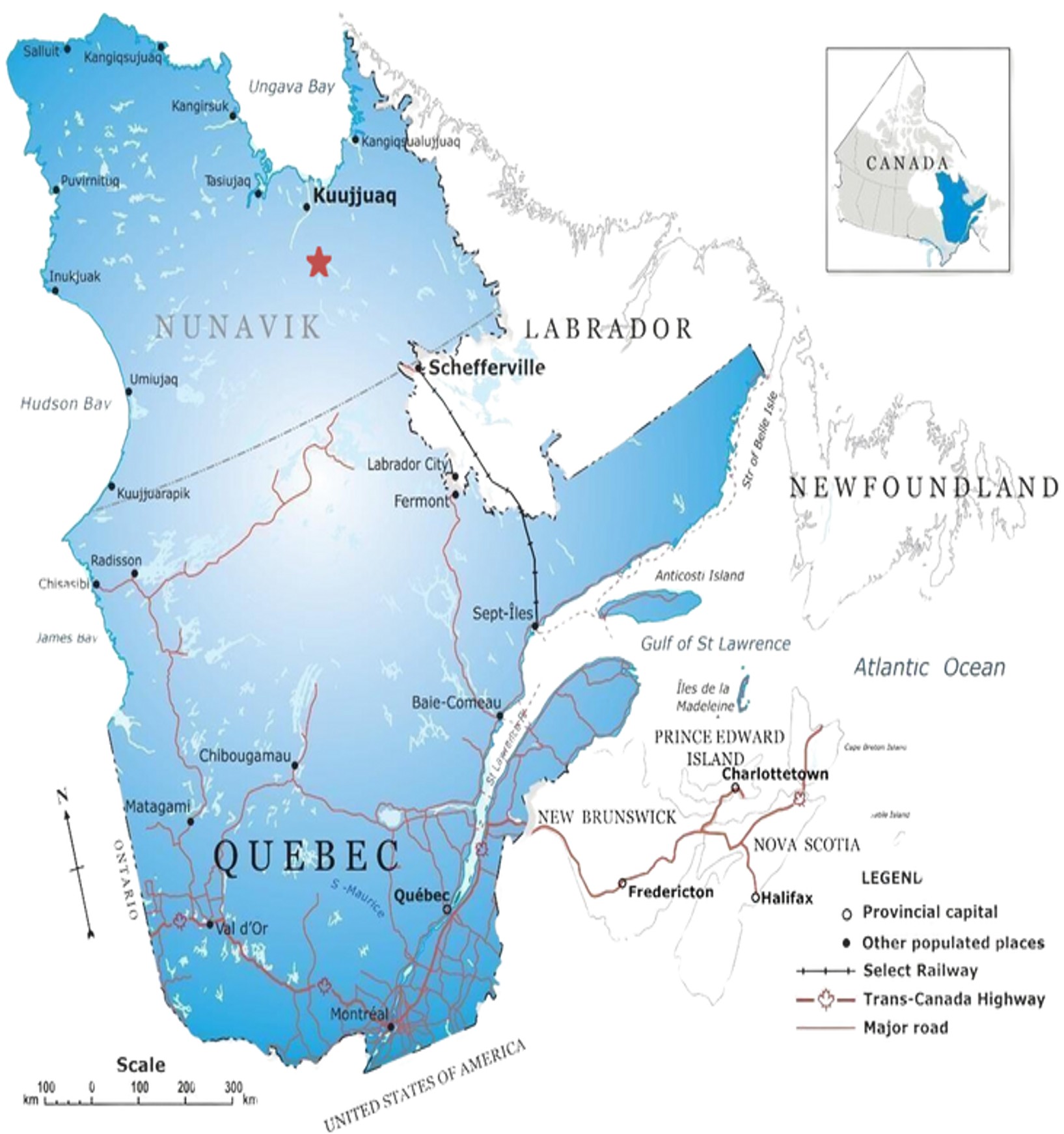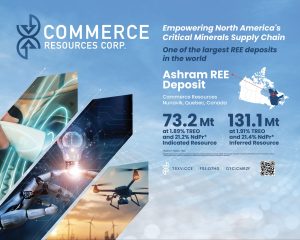Commerce Resources Positioned to Meet Rising Rare Earth Demand with Ashram Deposit

By Peter Kennedy
Lack of available infrastructure has long been a perceived impediment to the development of Commerce Resources Corp.’s [CCE-TSXV, CMRZF-OTCQX, D7HO-FSE] Ashram Rare Earth Deposit in Northern Quebec.
But as the world tries to wean itself off fossil fuels and demand continues to increase for rare earth elements (REEs), the company is taking key steps that could help it secure the funding required for necessary road and port infrastructure.
 Commerce is looking to secure a listing on the Australian Stock Exchange, a move that is expected to increase the company’s exposure to investors who wish to participate in the rare earths space. On January 15, 2025, the shares were priced at $0.075 and trade in a 52-week range of 17 cents and $0.07, leaving the company with a market cap of around $16 million.
Commerce is looking to secure a listing on the Australian Stock Exchange, a move that is expected to increase the company’s exposure to investors who wish to participate in the rare earths space. On January 15, 2025, the shares were priced at $0.075 and trade in a 52-week range of 17 cents and $0.07, leaving the company with a market cap of around $16 million.
The company has also applied to Canada’s Critical Mineral Infrastructure Fund (CMIF) for capital that would be used to assess the technical aspects of the construction of a 185-kilometre road that would connect the project from its location 135 kilometres south of Kuujjuaq (Nunavik Territory) to Ungava Bay. It is estimated that the road could cost about $300 million to complete.
Believing that the Ashram project’s proximity to the United States is a key benefit, the company has also applied for funding to the United States Department of Defense’s (DOD) financing arm, the Defense Industrial Base Consortium (DIBC).
Chris Grove, who is overseeing Corporate Development at Commerce Resources in Vancouver, said during an interview that there are good reasons to believe that the response to those applications will be positive.
Rare earth elements (REEs) are essential for the manufacture of the most dynamic permanent magnets, which are then essential to virtually every electric motor made and which are then found in applications as far-ranging as EVs, wind turbines, robots, H-Vac systems, Dyson products, and many more.
Grove points out that since the U.S. relies on China, the dominant global supplier, for about 80% of its rare earth imports, security of supply has been an issue, underlining the need to develop new sources of rare earths.
Since 2020, DOD has awarded more than US$439 million to establish rare earth element supply chains. A DOD report said there are 17 elements in the periodic table refereed to rare earth elements and DOD needs nearly all of them in some capacity. To address this critical need, the department has embarked on a five-year rare earth investment strategy to build domestic capacity. In doing so, DOD is mindful of the fact there is only one rare earth mine (Mountain Pass in California) currently active in the U.S.
Grove’s optimism is also based on the nature of the Ashram project itself.
REE deposits which have proven to be economic are primarily sourced from the rock type called carbonatites. Mineralogy is also extremely important, as there are only 4 REE host bearing materials that have ever been produced economically. These 4 minerals are monazite, bastnaesite, xenotime and loparite, with monazite being generally the most attractive as these types of deposits always have the greatest percentage of the 4 REE’s that are essential for permanent magnet manufacture. The company’s Ashram Deposit ranks as one of the largest REE (and Fluorspar) deposits globally, consisting of a monazite dominated, single mineralized body outcropping at surface.
The Ashram Deposit has a fluorspar component which makes it one of the largest potential sources of fluorspar in the world and a potential long-term supplier to the met-spar and acid-spar markets. The value of the project could also be enhanced by confirmation of a significant niobium discovery, including 24 metres of 0.91% Nb205, adjacent to the Ashram deposit.
“So, considering the grades of niobium we have released from the drilling of this prospect – being considerably higher than the Niobec mine – this project could feed it into the same complex and take advantage of the infrastructure here,” Grove said.
Commerce is working to update a 2015 preliminary economic assessment (PEA), which pegged the total required investment at $763 million, including a contingency of 25%. The PEA assumed that all costs for the transport road and port facility are covered by Commerce with no potential outside assistance.
The 2015 PEA said Ashram would be an open pit mine that would use conventional machinery, such as trucks, loaders and hydraulic shovels. It envisaged a base case for a 4,000 tonne per day operation (350 days per year) producing a 10% TREO (total rare earth oxide) mineral concentrate and further processing to a mixed rare earth carbonate product.
Roughly 36,000 tonnes of 99.9% pure mixed REC was anticipated to be produced annually, representing 16,850 tonnes of REOs
In May, 2024, the company released an updated mineral resource estimate (MRE) for the project. The primary objective was to increase the confidence from the inferred category to the indicated category to support economic and development studies. The conversion was highly successful with a 164% increase in the indicated resource compared to the previous MRE completed in 2012.
 The company said the updated MRE firmly establishes the project as a globally significant rare earth element deposit, and one of the largest monazite-mineralized carbonatite REE deposits in the world: It hosts 73.2 million tonnes at 1.89% TREO and 6.6% CaF2 (indicated), and 131.1 million tonnes at 1.91% TREO and 4.0% CaF2 (inferred) at a cut-off of $287 net metal return (NMR) per tonne.
The company said the updated MRE firmly establishes the project as a globally significant rare earth element deposit, and one of the largest monazite-mineralized carbonatite REE deposits in the world: It hosts 73.2 million tonnes at 1.89% TREO and 6.6% CaF2 (indicated), and 131.1 million tonnes at 1.91% TREO and 4.0% CaF2 (inferred) at a cut-off of $287 net metal return (NMR) per tonne.
In a news release, the company said Ashram continues to demonstrate very high NdPr distributions (i.e. percent of neodymium plus praseodymium oxide of the TREO) at 21.2% NdPr (indicated) and 21.4% NdPr (inferred), exceeding that of several other producers. The favourable distribution starts at surface, allowing these high value elements to be targeted early in a potential open-pit extraction scenario and therefore enhancing the project’s strategic value and operational efficiency.
The latest estimate positions the company to become the front runner in providing a long-term source of magnet feed REE supply to the North American. It will also be the new basis of future economic and development studies that further de-risk and unlock the development potential of this asset.
Commerce also reported that they had successfully increased the percentage of their flotation concentrate from the 10% used as the basis for their positive economics in 2012, up to 35% in 2024 and this will have significant benefits from a logistics perspective and in a potential reduction of operating cost.
Meanwhile, Commerce in keeping with its goal of listing on the Australian Stock Exchange in the first half of 2025 has revamped its board of directors.
In August 1, 2024, the company announced the appointment of Australian mining executive Ross Carroll as its new President, CEO and director. “With multiple decades of experience overseeing finance, M&A and strategy, operations and major projects across the natural resource sector, Carroll has a proven track record of leadership and strategic oversight, the company said in a press release.
Having revitalized the board and management, Carroll said the company is looking to establish a physical presence in Quebec, a province that consistently ranks amongst the top jurisdictions for mining development. The government of Quebec, through Investissement Quebec and Societe du Plan Nord, have been very supportive of mining companies with prospective operations in Quebec.
